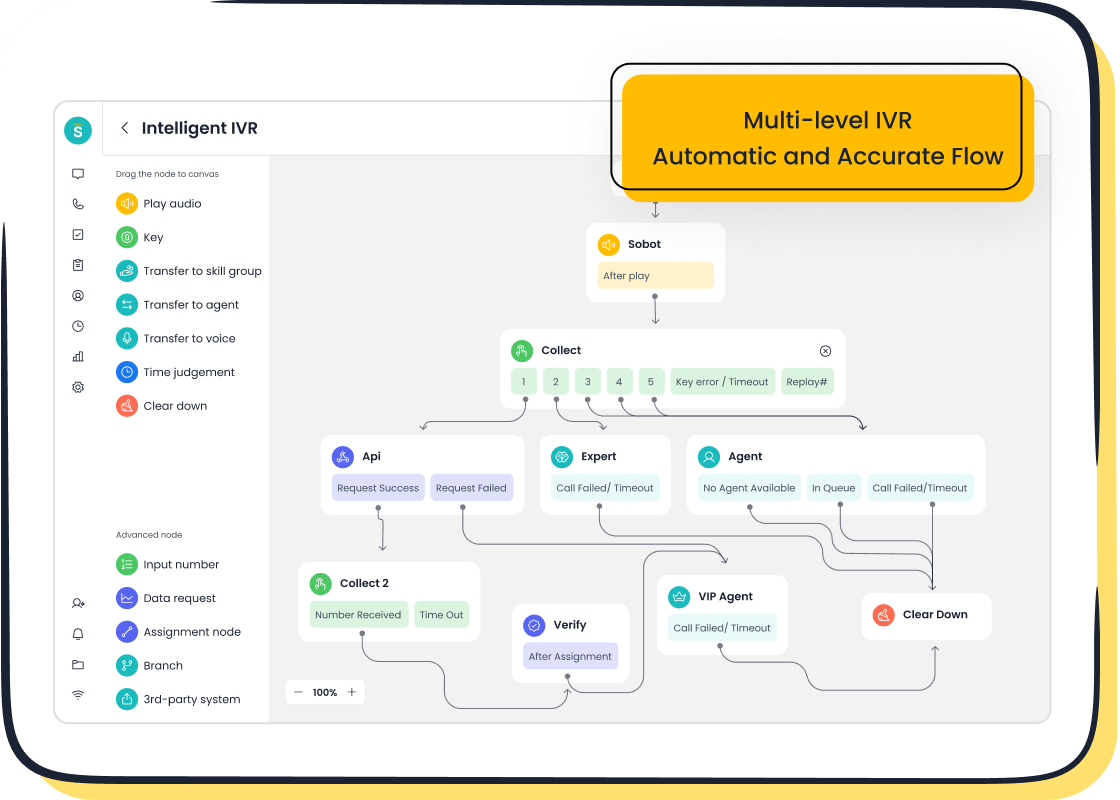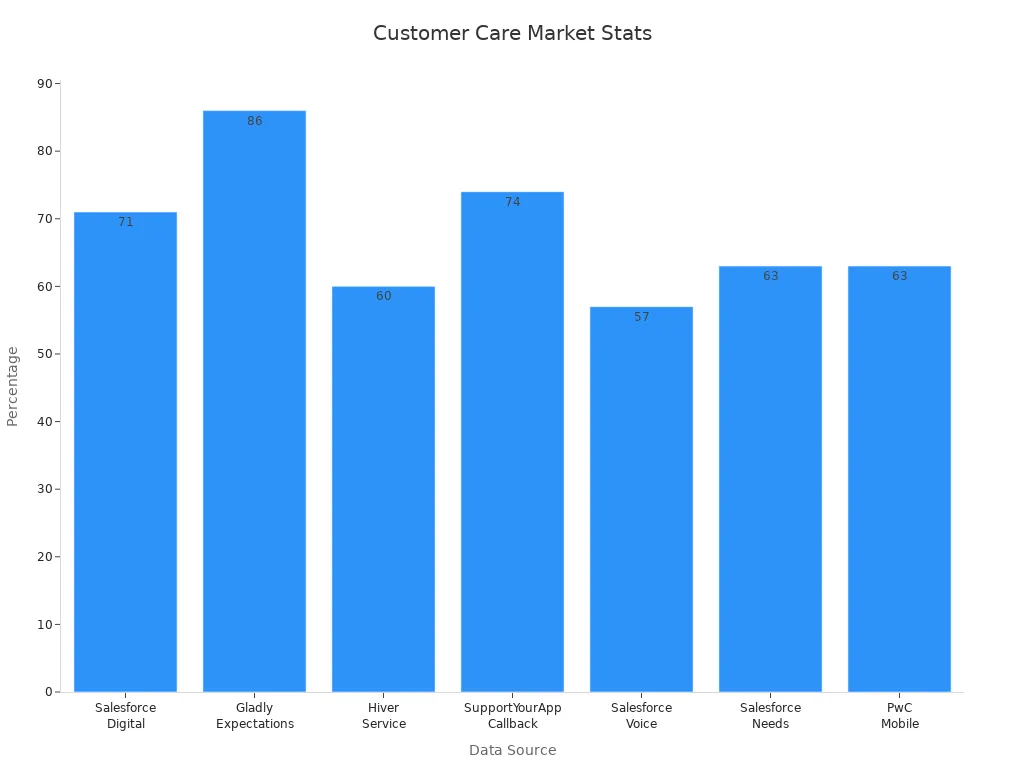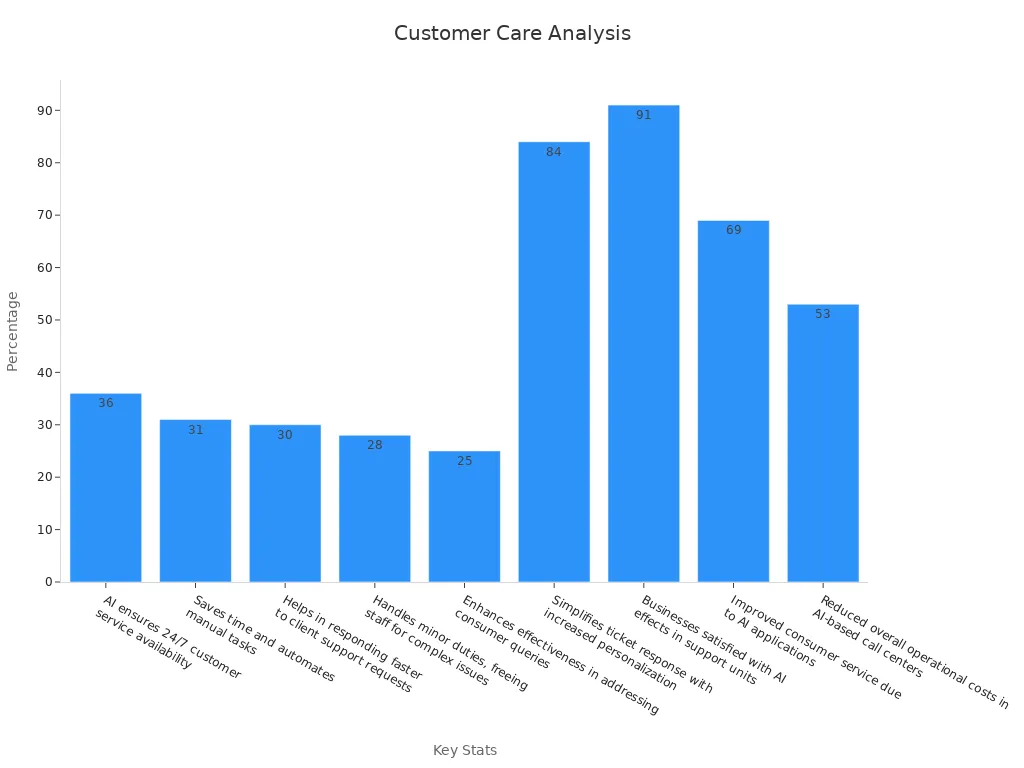Step-by-Step Guide to Adding Customer Care Channels to Your Strategy

When you think about growing your business, one thing stands out: keeping your customers happy. Customer care channels play a huge role in shaping the experience people have with your brand. They’re not just about solving problems; they build trust and loyalty. Offering high-quality support shows your customers you care, and that can make all the difference. Adding these channels to your strategy doesn’t just improve customer satisfaction—it creates lasting connections. It’s time to explore how you can make this happen with tools like Sobot.
Understanding Customer Care Channels

What Are Customer Care Channels?
Customer care channels are the various ways businesses interact with their customers to address questions, solve problems, and provide support. These channels act as bridges, connecting you with your audience and ensuring their needs are met. Whether it’s through email, social media, or phone calls, these touchpoints are essential for building trust and loyalty.
Think of them as tools that allow you to deliver a seamless customer service experience. For example, live chat on your website can provide instant answers, while email offers a more detailed and asynchronous option. Each channel serves a unique purpose, catering to different customer preferences and situations.
Here’s a quick overview of some common customer care channels:
| Customer Care Channel | Description |
|---|---|
| Self-Service | Empowers customers to find solutions independently. |
| Allows detailed communication without the need for real-time interaction. | |
| Social Media | Enables communication on platforms customers already use. |
| Text Messages | Provides quick updates and reminders. |
| Live Chat | Offers immediate assistance on websites or apps. |
The Role of Customer Care in Enhancing Customer Experience
Customer care isn’t just about solving problems—it’s about creating memorable experiences. When you provide effective communication channels, you show customers that their time and concerns matter. This builds trust and fosters loyalty.
Metrics like Customer Satisfaction (CSAT) and Net Promoter Score (NPS) highlight how impactful great customer service can be. For instance, a fast First Response Time (FRT) can leave a lasting impression, while a high First Contact Resolution Rate ensures customers don’t have to repeat themselves. These metrics aren’t just numbers—they reflect the quality of your customer service experience.

Tip: Tools like Sobot’s Voice/Call Center can help you improve these metrics by streamlining communication and ensuring every interaction is efficient and personalized.
Common Types of Customer Care Channels
Email and Live Chat
Email remains a go-to for detailed inquiries, while live chat offers instant support. Both are essential for providing flexibility. With Sobot’s Live Chat, you can unify messages from all channels into one workspace, making it easier to manage customer interactions.
Social Media and Phone Support

Social media allows you to engage with customers where they already spend time. Phone support, on the other hand, offers a personal touch. Did you know 42% of adults still prefer resolving issues over the phone? Sobot’s Voice/Call Center ensures these calls are handled efficiently with features like smart call routing and AI-powered voicebots.
AI-Powered Solutions like Sobot's Voice/Call Center
AI-powered tools are revolutionizing customer support. Sobot’s Voice/Call Center uses intelligent IVR and AI-driven voicebots to handle repetitive tasks, freeing up your team for complex issues. This not only improves efficiency but also enhances the overall customer experience.

Identifying Customer Needs and Preferences
Understanding what your customers want is the foundation of great customer service. When you know their preferences, pain points, and expectations, you can tailor your approach to meet their needs. Let’s dive into how you can uncover these insights.
Conducting Surveys and Feedback Collection
Surveys are one of the simplest ways to learn about your customers. They give you direct access to their thoughts and opinions. By asking the right questions, you can uncover what they love about your service and what needs improvement.
Here’s why surveys are so effective:
- They provide a snapshot of customer preferences, helping you shape your strategy.
- They highlight pain points and satisfaction levels, guiding product development.
- Targeted surveys reveal insights about demographics and behaviors, making your marketing more effective.
Pro Tip: Use tools like Sobot’s Ticketing System to automate feedback collection. This saves time and ensures you don’t miss valuable insights.
When designing surveys, keep them short and focused. Ask questions that matter, like:
- What do you value most in our customer service?
- How can we improve your experience?
These responses can help you refine your customer journey and deliver better service.
Analyzing Customer Behavior and Communication Trends
Your customers leave behind a trail of data every time they interact with your brand. Analyzing this data helps you understand their behavior and communication preferences.
Here are some ways to gather insights:
- Surveys: Collect data from large groups to identify trends in preferences and behaviors.
- Experiments: Use A/B testing to measure the impact of changes in your customer service approach.
- Machine Learning: Predictive analytics uncover patterns in customer behavior, helping you anticipate their needs.
For example, if you notice more customers reaching out via live chat, it’s a sign they prefer instant communication. You can use this insight to prioritize live chat support.
Did You Know? Sobot’s Omnichannel Solution consolidates customer interactions across platforms, making it easier to analyze trends and improve your customer experience.
Segmenting Customers Based on Preferences and Demographics
Not all customers are the same. Some prefer quick answers via live chat, while others want detailed explanations over email. Segmenting your audience helps you cater to these differences.
Here’s how segmentation works:
- Group customers by demographics like age, location, or income.
- Identify preferences, such as preferred communication channels or product interests.
- Tailor your customer service approach to each segment.
For instance, younger customers might prefer social media support, while older customers may lean toward phone calls. By understanding these preferences, you can create a personalized experience for every customer.
Quick Tip: Use Sobot’s Voice/Call Center to manage calls efficiently and provide tailored support based on customer profiles.
Segmentation doesn’t just improve customer satisfaction—it makes your service more efficient. When you know who you’re talking to, you can address their needs faster and more effectively.
Selecting the Right Customer Care Channels
Choosing the right customer care channels is like picking the perfect tools for a job. You need to ensure they align with your customers' needs, your business goals, and your budget. Let’s break it down step by step.
Evaluating Popular Platforms and Tools
Not all customer service tools are created equal. Some excel at streamlining communication, while others focus on automation or personalization. To find the right fit, you need to evaluate what each platform offers and how it aligns with your goals.
Here are some popular tools businesses often consider:
- Zendesk: Known for its conversational support and unified customer view.
- HubSpot: Offers a secure portal, self-service options, and automation features.
Cathrine Mula Davis, Director of Product Marketing at SuperOffice AS, says their customer care system "makes it easy for our customers to get in touch" and "saves our CX agents heaps of time to do what matters most – delivering personalized service that exceeds our customers’ expectations!"
Pricing also plays a role. For example:
- Zendesk for Service starts at $49/agent/month.
- HubSpot’s Service Hub starts at $17/month.
If you’re looking for a solution that combines efficiency, scalability, and personalization, Sobot’s Omnichannel Solution is worth exploring. It integrates multiple channels into one workspace, making it easier for your team to deliver exceptional customer service.
Matching Channels to Customer Expectations
Your customers expect more than just quick responses—they want meaningful interactions. Matching the right channels to their expectations ensures you’re meeting their needs effectively.
| Customer Expectation Type | Percentage |
|---|---|
| Effective resolutions with AI | 68% |
| Streamlined, comprehensive support | 80% |

For instance, if 68% of customers value AI-driven resolutions, tools like Sobot’s Voice/Call Center can help. Its AI-powered voicebots handle repetitive tasks, allowing your team to focus on complex issues. Similarly, if customers prefer streamlined support, Sobot’s unified workspace ensures all interactions are managed efficiently.
By understanding these preferences, you can prioritize the channels that matter most to your audience. Whether it’s live chat for instant answers or email for detailed queries, the right mix of channels enhances the overall customer experience.
Balancing Cost-Effectiveness with Customer Experience
Investing in customer service tools doesn’t have to break the bank. The key is finding a balance between cost and the quality of service you provide.
Here’s what the data says:
- 26% of consumers used live chat last year, with 73% expressing satisfaction.
- Social media satisfaction is rising, though only 10% of consumers use it.
- Phone and SMS have lower satisfaction rates, at 43% and 40%, respectively.
This shows that while live chat offers high satisfaction, it’s essential to consider your audience’s preferences. Sobot’s Omnichannel Solution helps you strike this balance. It consolidates all customer interactions into one platform, reducing operational costs while improving efficiency. Plus, its AI-driven automation handles repetitive tasks, saving time and resources.
Leveraging Sobot's Omnichannel Solution for Seamless Integration
Sobot’s Omnichannel Solution is designed to unify your customer care channels. It integrates voice, email, social media, and live chat into a single workspace. This ensures your team can deliver consistent and personalized support across all platforms. With features like AI-driven chatbots and real-time analytics, you can optimize your operations and enhance the customer experience—all while keeping costs in check.
Pro Tip: Use Sobot’s analytics to monitor performance and identify areas for improvement. This helps you continuously refine your strategy and stay ahead of customer expectations.
Aligning Channels with Business Goals
Setting Clear Objectives for Customer Service
Every great customer service strategy starts with clear objectives. You need to define what you want to achieve with your customer support efforts. Are you aiming to improve customer satisfaction, reduce response times, or boost customer retention? Setting measurable goals helps you stay focused and track progress.
Leading companies often set objectives like these:
| Objective | Target Description |
|---|---|
| Personalized customer experiences | Use AI to provide tailored solutions for 80% of interactions. |
| Omnichannel support | Ensure a consistent experience across all channels. |
| Proactive service | Anticipate issues before they happen. |
| Increase customer satisfaction | Raise rating from 85% to 90% within six months. |
| Reduce response times | Cut average response time from 24 hours to 12 hours. |
When you align your customer service goals with your overall business strategy, you create a roadmap for success. For example, if your business focuses on customer acquisition, you might prioritize faster response times to convert leads into loyal customers.
Ensuring Consistency with Brand Values
Your customer service should reflect your brand’s identity. Consistency builds trust and strengthens customer relationships. When your support aligns with your brand values, customers know what to expect at every touchpoint.
Here’s why consistency matters:
- It enhances recognition for both new and existing customers.
- It ensures a coherent experience across all customer touchpoints.
- It builds trust, which leads to greater customer loyalty.
For instance, if your brand emphasizes innovation, your customer support should use advanced tools like AI-driven chatbots or Sobot’s Voice/Call Center. This ensures your service feels modern and efficient, aligning with your brand promise.
Measuring Success Through Key Performance Indicators (KPIs)
Tracking the right KPIs is essential for evaluating your customer service strategy. These metrics show you what’s working and where you need to improve. Here are some key KPIs to monitor:
| KPI Name | Description | Formula |
|---|---|---|
| Customer Satisfaction Score (CSAT) | Measures customer satisfaction with interactions or experiences. | (Number of satisfied customers / Total respondents) * 100 |
| Net Promoter Score (NPS) | Assesses customer loyalty and likelihood to recommend. | % Promoters - % Detractors |
| First Contact Resolution Rate (FCR) | Percentage of inquiries resolved on first contact. | (Issues resolved on first contact / Total issues) * 100 |
| Average Resolution Time | Tracks time taken to resolve customer issues. | Total time spent resolving tickets / Number of tickets resolved |
For example, improving your FCR rate can enhance the customer journey by resolving issues faster. Similarly, tracking NPS helps you understand how likely customers are to recommend your brand, which directly impacts customer acquisition and loyalty.
By setting clear goals, staying consistent with your brand, and measuring success with KPIs, you can create a customer service strategy that drives results and builds lasting customer relationships.
Training and Empowering Your Customer Service Team
Your customer service team is the backbone of your customer service strategy. They’re the ones who interact with customers daily, solving problems and building trust. To ensure they perform at their best, you need to invest in their training and provide them with the right tools.
Providing Comprehensive Training on Tools and Processes

Training your team is the first step toward delivering effective customer service. Start by familiarizing them with the tools they’ll use, like Sobot’s Voice/Call Center. This platform simplifies call management with features like smart call routing and a unified workspace. When your team knows how to use these tools, they can handle customer inquiries more efficiently.
Processes are just as important. Teach your team how to follow workflows, prioritize tasks, and manage time effectively. For example, using Sobot’s AI-powered voicebots can automate repetitive tasks, allowing your team to focus on complex issues. Regular training sessions and updates ensure your team stays ahead of new features and industry trends.
Encouraging Empathy and Problem-Solving Skills
Empathy and problem-solving are essential for building strong customer relationships. When your team listens to customers and understands their concerns, they create a positive experience. Here’s why these skills matter:
- Improved customer experience: Empathy makes customers feel valued and understood.
- Increased customer loyalty: Customers who feel heard are more likely to stick with your brand.
- Better problem-solving: Understanding customer needs leads to quicker and more effective solutions.
Encourage your team to put themselves in the customer’s shoes. Role-playing exercises and real-life scenarios can help them practice these skills. A team that combines empathy with problem-solving can turn even the most challenging situations into opportunities to impress.
Empowering Teams with Tools like Sobot's Voice/Call Center
The right tools can make all the difference in customer support. Sobot’s Voice/Call Center equips your team with features like intelligent IVR and real-time monitoring. These tools streamline communication and reduce response times, helping your team deliver exceptional service.
For example, the platform’s AI-powered voicebots can handle routine inquiries, freeing up your team to focus on more complex tasks. With global number availability and seamless integration, Sobot ensures your team can support customers anywhere, anytime. Empowering your team with such tools not only boosts efficiency but also enhances the overall customer experience.
Tip: Regularly review your team’s performance using analytics from tools like Sobot. This helps identify areas for improvement and ensures your customer service strategy stays on track.
Implementing Tools and Technology

Choosing the Right CRM and Communication Tools
Selecting the right tools is crucial for building an effective customer service strategy. A good CRM and communication platform can streamline operations, improve customer interactions, and boost satisfaction. But how do you choose the right one? Start by identifying your business needs. Do you need better lead tracking, faster response times, or enhanced customer relationship management? Once you know your goals, look for tools that align with them.
Different industries have seen remarkable benefits from implementing CRM and communication tools. For example:
| Industry | Benefit Description | Improvement Metrics |
|---|---|---|
| Real Estate | Enhanced client relationship management and lead tracking. | 41% increase in revenue per sales rep. |
| Manufacturing | Improved customer service and operational efficiency. | 21-30% boost in sales. |
| Education | Better management of student relationships and communication. | 53% increase in student satisfaction. |
| Hospitality | Personalized guest experiences leading to increased loyalty. | Notable increases in customer loyalty. |
| Telecom | Enhanced customer service and streamlined billing processes. | 57% increase in sales revenue. |
Sobot’s Omnichannel Solution is an excellent choice for businesses looking to unify their customer service channels. It integrates voice, email, social media, and live chat into one platform, making it easier to manage customer interactions and improve efficiency.
Integrating Automation for Efficiency

Automation is a game-changer in customer service. It reduces repetitive tasks, speeds up response times, and allows your team to focus on complex issues. Tools like Sobot’s Voice/Call Center use AI-powered voicebots to handle routine inquiries, ensuring customers get quick and accurate responses. This not only saves time but also enhances the overall customer experience.
For example, imagine a customer calling to check their order status. Instead of waiting for an agent, an AI voicebot can provide the information instantly. This kind of automation improves efficiency and keeps customers happy. Plus, it helps your team stay productive by reducing their workload.
Ensuring Data Security and Privacy Compliance
Data security is non-negotiable in today’s digital world. Customers trust you with their personal information, and it’s your responsibility to protect it. Compliance with regulations like GDPR and NIST not only safeguards data but also builds trust and loyalty.
| Evidence | Explanation |
|---|---|
| Compliance with regulations such as GDPR and NIST | Establishes guidelines for data protection, fostering trust among stakeholders. |
| Adherence to data security compliance | Linked to improved brand reputation and customer loyalty. |
| Implementation of robust controls and security measures | Protects sensitive information and mitigates potential financial and reputational damages. |
How Sobot's Voice/Call Center Enhances Operational Efficiency
Sobot’s Voice/Call Center takes data security seriously. It offers encrypted data transfer and ensures compliance with global standards. With features like intelligent IVR and real-time monitoring, it not only protects customer data but also boosts operational efficiency. The platform’s 99.99% uptime ensures reliable service, giving your customers the seamless experience they deserve.
Establishing Feedback Loops for Continuous Improvement
Creating a feedback loop is essential for improving your customer service strategy. It ensures you’re always listening to your customers and adapting to their needs. Let’s explore how you can collect, analyze, and act on feedback to deliver better experiences.
Collecting Feedback from Customers Regularly
Regularly gathering customer feedback is like having a compass—it guides your decisions. Surveys, reviews, and direct interactions are great ways to understand what your customers think. For example, asking questions like, “How satisfied are you with our service?” can reveal valuable insights.
Feedback isn’t just about fixing problems. It’s also about spotting opportunities to enhance your customer service. Deloitte’s research shows that customer-centric companies are 60% more profitable. Plus, customers are willing to spend 16% more for a better experience. This means listening to your customers doesn’t just improve satisfaction—it boosts your bottom line.
Tip: Use tools like Sobot’s Ticketing System to automate feedback collection. It ensures you never miss a chance to hear from your customers.
Analyzing Feedback to Identify Areas for Improvement
Once you’ve collected feedback, the next step is to make sense of it. Analytical methods like predictive analytics and machine learning can uncover patterns in customer behavior. For instance, if many customers mention slow response times, it’s a clear sign to improve efficiency.
| Analytical Method | Description |
|---|---|
| Predictive Analytics | Identifies patterns and forecasts future trends using historical data. |
| Machine Learning | Detects hidden patterns in data, enabling proactive responses to customer behavior. |
| Data Visualization | Transforms complex data into visual formats, making it easier to identify trends and actionable insights. |
Sobot’s Omnichannel Solution simplifies this process by consolidating customer interactions into one platform. Its analytics tools help you track trends and pinpoint areas for improvement, ensuring your customer service strategy stays on target.
Iterating and Updating Customer Care Strategies
Using Sobot's Analytics to Drive Data-Driven Decisions
Improvement doesn’t happen overnight. It’s an ongoing process of testing, learning, and refining. Start by using customer feedback to identify gaps in your service. Then, implement changes and measure their impact.
| Methodology | Description |
|---|---|
| User Feedback and Research | Collecting insights through surveys and usability testing to identify areas for improvement. |
| A/B Testing and Experimentation | Conducting controlled experiments to evaluate design variations and optimize user experiences. |
| Iterative Design Process | Continuous prototyping and testing to refine designs based on user feedback. |
Sobot’s analytics tools make this process seamless. They provide real-time insights, helping you track the success of your updates. For example, if you introduce AI-powered voicebots to handle repetitive queries, Sobot’s dashboards can show how this change impacts response times and customer satisfaction.
By iterating and refining your strategy, you ensure your customer service evolves with your customers’ needs. This not only improves their experience but also strengthens their loyalty to your brand.
Customer care channels are more than just tools—they’re the backbone of great customer service. They help you connect with your audience, solve problems, and build trust. By integrating the right channels into your strategy, you can boost customer satisfaction and loyalty, creating experiences that keep people coming back.
To get started, focus on understanding your customers’ needs. Choose tools that align with their preferences and your business goals. Remember, continuous improvement is key. Regularly analyze feedback and adapt your approach to stay ahead of expectations.
Did You Know? Businesses using AI in customer support report a 91% satisfaction rate, with 53% seeing reduced operational costs.

Ready to take your customer service to the next level? Explore Sobot’s Voice/Call Center. With features like intelligent IVR and AI-powered voicebots, it’s designed to deliver quality support and enhance customer retention. Start building stronger relationships today!
FAQ
What are customer care channels, and why are they important?
Customer care channels are ways you connect with customers, like email, live chat, or phone. They’re important because they help you solve problems, answer questions, and build trust. Happy customers are loyal customers, and these channels make that happen.
How do I choose the right customer care channels for my business?
Start by understanding your customers’ preferences. Do they prefer live chat, email, or phone calls? Then, match those preferences with tools that fit your goals. For example, Sobot’s Omnichannel Solution integrates multiple channels, making it easier to manage customer interactions.
Can automation improve customer service?
Absolutely! Automation speeds up responses and handles repetitive tasks. Tools like Sobot’s Voice/Call Center use AI-powered voicebots to answer common questions. This frees up your team to focus on more complex issues, improving efficiency and customer satisfaction.
How does Sobot ensure data security in its tools?
Sobot prioritizes data security with encrypted data transfer and compliance with global standards like GDPR. This ensures your customers’ information stays safe while you deliver seamless support through tools like the Voice/Call Center.
What industries benefit most from Sobot’s solutions?
Sobot serves industries like retail, finance, gaming, and education. Whether you’re managing customer inquiries during peak shopping seasons or providing 24/7 support, Sobot’s tools help you improve efficiency and customer satisfaction across various sectors.
See Also
10 Essential Steps for Effective Omnichannel Contact Centers
10 Key Tips for Selecting Social Media Support Tools
Comprehensive Guide to Omnichannel Call Center Solutions